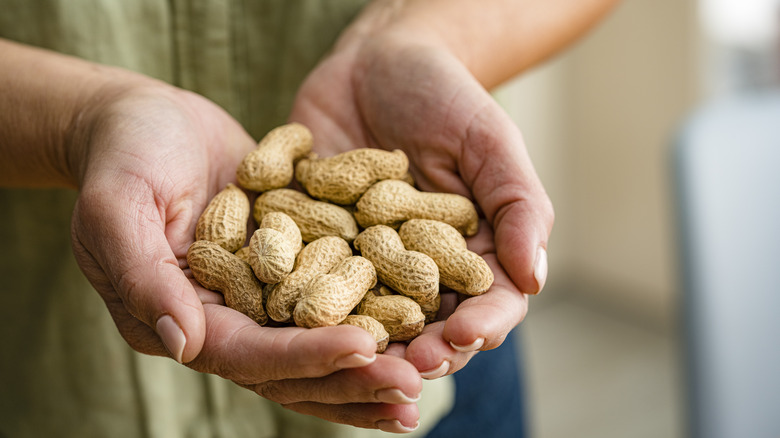One Type Of Legume Has The Most Amount Of Protein Per Gram
Legumes often get lumped in with beans, but what exactly are legumes? Plants that are categorized as legumes are those that bear the same type of fruit within a single pod, explains MedicineNet. Beans, on the other hand, are seeds derived from a variety of plants. While beans do qualify as legumes, not every legume shares the title of being a bean. You might not initially think of legumes as a powerhouse source of protein, but these tiny foods shouldn't be overlooked. In fact, there's one type of legume that outranks all others when it comes to protein content, but you might be shocked to find out it's a legume in the first place.
Widely believed to be a nut, peanuts are actually members of the legume family, explains Healthline. In the world of nutrition, however, peanuts are welcomed with open arms as a nut. When pitted against other types of popular nuts, like walnuts, almonds, or cashews, peanuts surpass them all in protein content. Let's see how peanuts stack up against other kinds of legumes.
Peanuts have more protein per gram than chickpeas, green beans, and peas
According to the U.S. Department of Agriculture (USDA), in 1 gram of salt-free, dry-roasted peanuts (the equivalent of a single peanut) you'll get 0.244 grams of protein. Chickpeas, alternatively referred to as garbanzo beans, are also rich in protein. In a 100-gram serving of cooked chickpeas with no salt added you'll find 8.86 grams of protein (via USDA). If we do a little math to determine what that comes out to per gram, peanuts still come out on top. You'd find approximately 0.088 grams of protein in 1 gram of chickpeas compared to peanuts' 0.244 grams.
Although green beans are unexpectedly high in protein, they simply can't hold a candle to peanuts. A 100-gram serving of cooked green beans with no added fat contains 1.9 grams of protein (via USDA). When divided down, this comes out to 0.019 grams of protein per gram of green beans. Cooked green peas are also a beloved member of the legume family, yet this popular side dish only totals about 0.053 grams of protein per gram (via USDA). As such, the peanut reigns supreme.
The nutritional value of peanut proteins
Peanuts are one legume not to be ignored when considering your daily protein intake. Peanuts eclipse all other nuts when it comes to protein content, and have amounts of the nutrient equal to or greater than those found in a serving of beans, as outlined in a 2016 scientific review published in the Journal of Food Science and Technology. Peanuts also score on par with eggs and meat in regards to the nutritional value of their proteins that are beneficial to human health and growth, as measured by the Protein Digestibility Corrected Amino Acid Score (PDCAAS). For example, peanuts are the number one source of the protein arginine, which is essential to wound healing, immunity, hormone function, and more (via WebMD).
Because peanuts are a plant-protein source, they are also rich in fiber, which comes with additional potential health benefits, such as lowering cholesterol levels, supporting gut health, and regulating blood sugar levels (via Mayo Clinic). But what if we prefer our peanuts as a creamy spread, instead? Click here to find out if peanut butter is as rich in protein and other nutrients as animal sources of protein.



